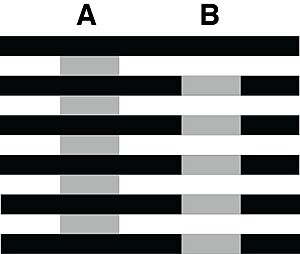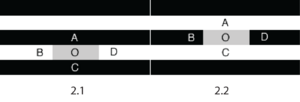White's illusion facts for kids
White's illusion is a cool optical illusion that tricks your brain about how bright things are. Imagine a pattern of black and white stripes. In this illusion, some of these stripes are replaced with gray rectangles. Even though all the gray rectangles are actually the same color, they look different! The gray rectangles next to black stripes seem darker, and the ones next to white stripes seem lighter. It's a bit like magic, but it's just your brain playing tricks! This illusion is usually seen with shades of gray, but a similar trick happens with colors, called Munker-White's illusion.
How Your Brain Sees Brightness
Our eyes have special cells that react to light. When these cells are stimulated, they send signals to our brain. Interestingly, cells that are next to each other can affect how much their neighbors respond. This is called lateral inhibition. It means that when one cell is very active, it can make its neighboring cells less active. This helps us see edges and contrasts better.
Why Lateral Inhibition Doesn't Explain White's Illusion
For many optical illusions, lateral inhibition helps explain why we see things differently. For example, it helps explain why a gray square looks brighter on a black background than on a white background.
However, lateral inhibition doesn't seem to explain White's illusion. Let's look at Figure 2.
If lateral inhibition were the main reason, the gray areas next to black stripes should look lighter because they get less "inhibition" from the dark areas. And the gray areas next to white stripes should look darker because they get more "inhibition" from the bright areas. But with White's illusion, the opposite happens! The gray areas next to black stripes look darker, and the gray areas next to white stripes look lighter. This shows that something else is going on in our brains.
The Idea of Belongingness
One idea that tries to explain White's illusion is called the belongingness theory. This theory suggests that our brain decides how bright something is based on what it seems to "belong" to.
Think about the gray rectangle A in Figure 1. It looks like it's part of the white stripes around it. So, our brain thinks it should be brighter, but because it's gray, it ends up looking darker compared to the white.
Now look at rectangle B in Figure 1. It seems to "belong" to the black stripes. So, our brain expects it to be darker. But since it's gray, it ends up looking lighter compared to the black.
Because of this "belongingness," rectangle A (which seems to be on a white background) appears darker than rectangle B (which seems to be on a black background), even though they are the exact same shade of gray!
Not all scientists agree completely with the belongingness theory. Some think it's similar to lateral inhibition, just described in a different way. But it's one of the main ideas for understanding this tricky illusion.



